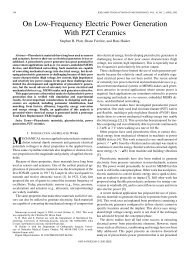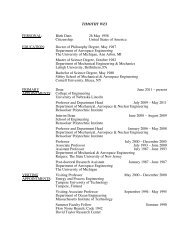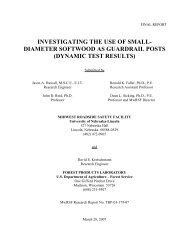Download .pdf of this edition. - College of Engineering - The ...
Download .pdf of this edition. - College of Engineering - The ...
Download .pdf of this edition. - College of Engineering - The ...
Create successful ePaper yourself
Turn your PDF publications into a flip-book with our unique Google optimized e-Paper software.
ScHoRR cENTER<br />
TRANSFoRmS<br />
cSE FAcIlITIES<br />
by Carole Wilbeck<br />
<strong>The</strong> UNL supercomputer known as Red has moved to<br />
a very appropriate new home: adjacent to Memorial<br />
Stadium. <strong>The</strong> other campus super computer, PrairieFire,<br />
joins it in a remodeled space that’s a significant improvement<br />
over prior venues in the former Miller and Paine Building and<br />
Avery Hall. Moving in <strong>this</strong> past winter meant a different (but<br />
also very celebratory) kind <strong>of</strong> “tunnel walk”—with the machines,<br />
said Rich Sincovec, Henson Pr<strong>of</strong>essor and Chair <strong>of</strong> Computer<br />
Science and <strong>Engineering</strong>.<br />
Located under the stadium’s south wing, the June and Paul<br />
Schorr III Center for Computer Science and <strong>Engineering</strong> was<br />
redesigned by Michael Penn with Sinclair Hille, architects. <strong>The</strong><br />
work addressed the project’s challenges with several energy<br />
efficient approaches:<br />
• screen louvers outside the building allow for varying light<br />
levels, and interior sensors control lighting and temperature<br />
based on occupancy;<br />
• substantial plumbing and power (formerly used by Husker<br />
football laundry) are repurposed to serve the computers’<br />
demanding cooling needs, with high-volume primary<br />
(campus chilled water) and backup (glycol) systems; and<br />
• 18-inch elevated floors and perforated ceilings in the room<br />
housing the supercomputers aid cooling (high-capacity<br />
central ventilation also helps air flow around the computers,<br />
placed back to back).<br />
From the Schorr Center’s flexible cluster workspaces to the<br />
generous <strong>of</strong>fices, it’s all been “done right,” added David Swanson,<br />
director <strong>of</strong> the Research Computing Facility and research<br />
assistant pr<strong>of</strong>essor with Computer Science and <strong>Engineering</strong>.<br />
Most importantly, future hardware additions can be readily<br />
accommodated. Swanson noted that nearly 800 processing cores<br />
are now co-located in the Schorr Center—and that number<br />
that will triple in summer 2008. Yet even now, with a 10-gigabit<br />
link to Internet2, “the campus can provide, as an example, for<br />
performing arts the high-definition broadcasts that were simply<br />
not possible here two years ago.”<br />
Echoes <strong>of</strong> “the sea <strong>of</strong> Red” crowd noise resonate in the hum <strong>of</strong><br />
the machine room, as the new (quieter) neighbors in the Schorr<br />
Center enjoy their upgraded surroundings. Excitement generated<br />
an open house preview in April, but watch for the center’s <strong>of</strong>ficial<br />
dedication <strong>this</strong> fall.<br />
<strong>Engineering</strong>@Nebraska 23.







